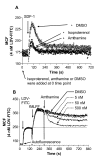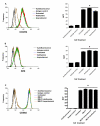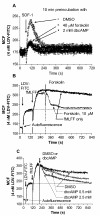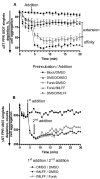Galphas-coupled receptor signaling actively down-regulates alpha4beta1-integrin affinity: a possible mechanism for cell de-adhesion
- PMID: 18534032
- PMCID: PMC2442041
- DOI: 10.1186/1471-2172-9-26
Galphas-coupled receptor signaling actively down-regulates alpha4beta1-integrin affinity: a possible mechanism for cell de-adhesion
Abstract
Background: Activation of integrins in response to inside-out signaling serves as a basis for leukocyte arrest on endothelium, and migration of immune cells. Integrin-dependent adhesion is controlled by the conformational state of the molecule (i.e. change in the affinity for the ligand and molecular unbending (extension)), which is regulated by seven-transmembrane Guanine nucleotide binding Protein-Coupled Receptors (GPCRs). alpha4beta1-integrin (CD49d/CD29, Very Late Antigen-4, VLA-4) is expressed on leukocytes, hematopoietic stem cells, hematopoietic cancer cells, and others. Affinity and extension of VLA-4 are both rapidly up-regulated by inside-out signaling through several Galphai-coupled GPCRs. The goal of the current report was to study the effect of Galphas-coupled GPCRs upon integrin activation.
Results: Using real-time fluorescent ligand binding to assess affinity and a FRET based assay to probe alpha4beta1-integrin unbending, we show that two Galphas-coupled GPCRs (H2-histamine receptor and beta2-adrenergic receptor) as well as several cAMP agonists can rapidly down modulate the affinity of VLA-4 activated through two Galphai-coupled receptors (CXCR4 and FPR) in U937 cells and primary human peripheral blood monocytes. This down-modulation can be blocked by receptor-specific antagonists. The Galphas-induced responses were not associated with changes in the expression level of the Galphai-coupled receptors. In contrast, the molecular unbending of VLA-4 was not significantly affected by Galphas-coupled GPCR signaling. In a VLA-4/VCAM-1-specific myeloid cell adhesion system, inhibition of the VLA-4 affinity change by Galphas-coupled GPCR had a statistically significant effect upon cell aggregation.
Conclusion: We conclude that Galphas-coupled GPCRs can rapidly down modulate the affinity state of VLA-4 binding pocket through a cAMP dependent pathway. This plays an essential role in the regulation of cell adhesion. We discuss several possible implications of this described phenomenon.
Figures








Similar articles
-
Nitric oxide/cGMP pathway signaling actively down-regulates α4β1-integrin affinity: an unexpected mechanism for inducing cell de-adhesion.BMC Immunol. 2011 May 17;12:28. doi: 10.1186/1471-2172-12-28. BMC Immunol. 2011. PMID: 21586157 Free PMC article.
-
Carbon monoxide down-regulates α4β1 integrin-specific ligand binding and cell adhesion: a possible mechanism for cell mobilization.BMC Immunol. 2014 Oct 31;15:52. doi: 10.1186/s12865-014-0052-1. BMC Immunol. 2014. PMID: 25367365 Free PMC article.
-
Regulation of cell adhesion by affinity and conformational unbending of alpha4beta1 integrin.J Immunol. 2007 Jun 1;178(11):6828-39. doi: 10.4049/jimmunol.178.11.6828. J Immunol. 2007. PMID: 17513731
-
VLA-4-mediated interactions between normal human hematopoietic progenitors and stromal cells.Leuk Lymphoma. 1997 Feb;24(5-6):423-35. doi: 10.3109/10428199709055581. Leuk Lymphoma. 1997. PMID: 9086434 Review.
-
An Overview of the α4β1 Integrin and the Potential Therapeutic Role of its Antagonists.Curr Med Chem. 2021;28(29):5884-5895. doi: 10.2174/0929867328666210217153609. Curr Med Chem. 2021. PMID: 33596793 Review.
Cited by
-
Adhesion Assay for Murine Bone Marrow Hematopoietic Stem Cells.Bio Protoc. 2017 Feb 20;7(4):e2135. doi: 10.21769/BioProtoc.2135. eCollection 2017 Feb 20. Bio Protoc. 2017. PMID: 34458456 Free PMC article.
-
Discovery of very late antigen-4 (VLA-4, alpha4beta1 integrin) allosteric antagonists.J Biol Chem. 2011 Feb 18;286(7):5455-63. doi: 10.1074/jbc.M110.162636. Epub 2010 Dec 3. J Biol Chem. 2011. PMID: 21131351 Free PMC article.
-
Differential TNF production by monocyte subsets under physical stress: blunted mobilization of proinflammatory monocytes in prehypertensive individuals.Brain Behav Immun. 2013 Jan;27(1):101-8. doi: 10.1016/j.bbi.2012.10.003. Epub 2012 Oct 6. Brain Behav Immun. 2013. PMID: 23046723 Free PMC article.
-
FRET detection of lymphocyte function-associated antigen-1 conformational extension.Mol Biol Cell. 2015 Jan 1;26(1):43-54. doi: 10.1091/mbc.E14-06-1050. Epub 2014 Nov 5. Mol Biol Cell. 2015. PMID: 25378583 Free PMC article.
-
Overview: assays for studying integrin-dependent cell adhesion.Methods Mol Biol. 2012;757:3-14. doi: 10.1007/978-1-61779-166-6_1. Methods Mol Biol. 2012. PMID: 21909902 Free PMC article. Review.
References
-
- De Meyer SF, Vanhoorelbeke K, Ulrichts H, Staelens S, Feys HB, Salles I, Fontayne A, Deckmyn H. Development of monoclonal antibodies that inhibit platelet adhesion or aggregation as potential anti-thrombotic drugs. Cardiovasc Hematol Disord Drug Targets. 2006;6:191–207. doi: 10.2174/187152906778249536. - DOI - PubMed
Publication types
MeSH terms
Substances
Grants and funding
LinkOut - more resources
Full Text Sources
Other Literature Sources
Miscellaneous

